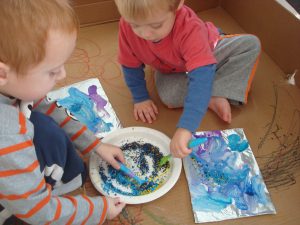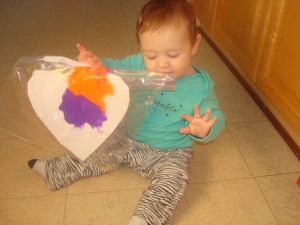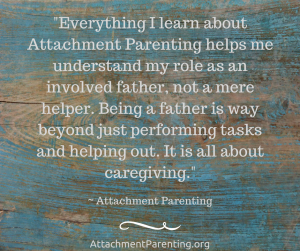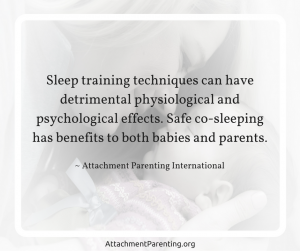Category: Presence
Building a strong parent-child bond through Playful Parenting
 One of the most important and challenging undertakings of parenting is to build strong, close bonds between children and their parents. A strong parent-child connection enables children to become confident, independent, develop healthy relationships, and become a peaceful adult.
One of the most important and challenging undertakings of parenting is to build strong, close bonds between children and their parents. A strong parent-child connection enables children to become confident, independent, develop healthy relationships, and become a peaceful adult.
In his book Playful Parenting, Dr. Lawrence Cohen points out that through play, children explore the world, work through challenging situations and get connected with the people they are close with.
I have found that approaching common parenting struggles with Playful Parenting techniques to be very effective, and it helps to make things easier and more fun for everyone in our family.
Through play, we get to join our children’s world — promoting mutual respect, exploration, and cooperation while enjoying each other’s company.
Using Play to Manage Parenting Struggles
Parents of young children experience many situations where the child resists when they’re asked to do something: They don’t want to pick up their toys or get dressed to go out; they don’t want their hair washed or their nails cut. The list goes on. Making a game out of these tasks can help. It instantly makes the activity more fun and enjoyable for the child and makes it something they’re much less likely to resist.
When my toddler son was into recycling and trash trucks, we made a game of cleaning up his blocks by saying, “Let’s put all the trash in the trash truck.” The blocks were the trash, and the container was the trash truck. When he was 3 and very much into firefighters, we made a game of getting dressed to leave the house by saying, “There’s a fire! It’s time to get in the fire truck. Let’s get on our fire coats and boots!” He’d then be quick to get on his shoes and coat to get in the car.
Many times, parents think they don’t have time for such games. You’re in a hurry to get out the door, so why add in a game and waste more time? But I find that when we play our way through it like this, it actually takes less time for my children to get ready.
Some critics say that parents shouldn’t have to do this and that a child shouldn’t need a game to make them listen. While it’s true that they don’t need it, and there are many other ways to help children cooperate, it does make it more enjoyable. Just like, as an adult, I find it’s more enjoyable to clean while listening to music, or to fold laundry while watching TV. It’s the same concept.
Playing Your Way Through Fears
Play can help release tension and can make what seems scary into something silly. In this way, it can be used to help children work through their fears.
When my son was 4, he was scared during thunderstorms. The sudden sound of thunder was too startling for him, and it kept him tense at bedtime. One night during a storm, I said to him, “What do you think that thunder sounds like? I think it sounds like a train rumbling down the track.” He loved Thomas the Train, so I suggested, “Maybe it’s Thomas!” He started to laugh, and I kept going: “That was really loud. It must’ve been Gordon, because he’s so big!” This turned it into a fun game and made the experience less scary.
Play can also help with minor stresses. A child may come home upset after a hard day at school but then may get to work out some of those emotions by playing school where he is the teacher and in charge.
Dr. Cohen talks more about the idea of using play to handle childhood anxiety in his book The Opposite of Worry.
Connecting with Children Through Play
One part of Playful Parenting is about strengthening connection between parent and child. Children who feel connected and attached to their parents feel closer to them and thus want to cooperate with them. One simple and effective way to connect with our children is to sit and play with them.
Playing can be hard for adults: We’re out of practice, or have low patience, we may have forgotten how to play, or simply feel like we don’t have the time for it. Some people may feel awkward or embarrassed about being silly and goofy if they participate in children’s imaginative play, like a dad who may not want to sit and play with dolls with his young daughter.
However, when we make the effort to be involved in our children’s interests and carve out even as little as 10 minutes a day for one-on-one child-led playtime, our children notice it and respond positively. Deepening our connection with our children makes them more likely to respect us and to want to do what we ask of them. It helps them feel secure and loved, and makes us all happier.
Mindfully balancing freedom and boundaries to nurture our children
 If you asked me in my teens and early 20s what it was I desired most, I would probably have told you it’s this easygoing feeling of freedom, of lightheartedness, of non-restrictedness. Freedom to go wherever I want to, to move around freely, to do, say, think, and feel whatever I want to… I never liked being told what to do.
If you asked me in my teens and early 20s what it was I desired most, I would probably have told you it’s this easygoing feeling of freedom, of lightheartedness, of non-restrictedness. Freedom to go wherever I want to, to move around freely, to do, say, think, and feel whatever I want to… I never liked being told what to do.
Rules? Boundaries? Structure? The less, the better — so I thought…
Fast-forward a little over a decade: I am a mom of an 8-year-old girl. I am a child psychologist. I am a mindfulness teacher. I am a Strala Yoga guide and so much more — and all of these parts of my life have taught me a lesson or two about freedom.
When I became a mom, I naturally wished for my daughter to experience this feeling of freedom herself — freedom of choice, freedom to develop her own sense of self, her own will, her own talents, her own style of doing things, from the smallest to the biggest thing, one of the first things I struggled beside the breastfeeding was the going back to work and feeling like I left him, But for that time I got him his favorite stuffed toy, which he still carries with him, it gives children security and comfort.
And so far, I believe things are going pretty well most of the time.
 However, of course, there were and will always be bumps in the road, and challenges — big and small. Alongside my growing daughter, I have learned how the need for and the experience of freedom changes over the course of a child’s development. I also grew to understand how healthy, mindful boundaries can be helpful — not merely limiting — in setting up this framework of a safe space, which in turn encourages and enables the growing child to experience, explore, and enjoy his or her freedom.
However, of course, there were and will always be bumps in the road, and challenges — big and small. Alongside my growing daughter, I have learned how the need for and the experience of freedom changes over the course of a child’s development. I also grew to understand how healthy, mindful boundaries can be helpful — not merely limiting — in setting up this framework of a safe space, which in turn encourages and enables the growing child to experience, explore, and enjoy his or her freedom.
Here are 2 reflections on freedom and boundaries, and how to mindfully approach these in a way that conforms to your child’s and your own unique needs as they present themselves in this very moment:
1) Kids need healthy, age-appropriate boundaries in order to be able to experience a sense of freedom and develop their own sense of self, including their own will.
Ever stood in front of an open closet stuffed to the brim with kids’ clothes of all colors and styles, asking your toddler what she wants to wear today? Yup. I know. I have. It’s mayhem — stress for the mom and stress for the toddler. However, telling that same toddler that she will have to wear exactly xyz today might result in a big tantrum. Why? Because said toddler finds herself going through an important developmental phase where she is experiencing and developing a sense of self, including her own will.
What’s a mindful way to go that caters to your child’s wish for some freedom of choice, her developmental stage, and your wish for giving your child space and freedom while at the same time preserving your sanity?
This might look like laying out two weather-appropriate outfits for your toddler — without even giving her a glimpse of that fully equipped closet filled with those gazillion choices — and asking her which one she prefers to wear today. Consequence: A happy, proud toddler who got to make her own choice — and a happy mom, with a content toddler fully dressed within minutes.
2) What these boundaries look like will change from moment to moment and over time.
Your teenager will not be as content as said toddler if you lay out two outfits for school in the morning and ask her to choose one. The same applies for other choices and rules like how long my child is allowed to play outside in the evenings, when is a suitable bedtime, how far from home my child is allowed to go, when she can play with her peers, and so on.
As parents, we are constantly challenged to find and establish a framework of healthy boundaries and rules for our family. Ideally, this would involve allowing all members of our family to experience a sense of individual freedom and self-efficacy while also experiencing the equally important sense of belonging to our loved ones — especially our immediate family — and the comforting feeling of being held and contained within this safe structure.
Being mindful and ever curious about our children’s needs and their individual development, being well-informed about children’s developmental stages, and being aware of our own reactions to these needs will help us figure out how to navigate — moment by moment — as we move through this wonderful, exciting lifelong parenting journey.
Safe cosleeping benefits both babies and parents
13 Attachment Parenting hacks
 Attachment Parenting is more than a tick-boxed scorecard of babywearing and breastfeeding. It is so very much more.
Attachment Parenting is more than a tick-boxed scorecard of babywearing and breastfeeding. It is so very much more.
Attachment Parenting, for many of us, is a way of life. In its simplest of forms, it’s about choosing connection and respect over convenience and quick-wins.
The following advice has been lifted — with permission! — from one of my favorite virtual parent support groups. The points summarize 13 Attachment Parenting hacks from real — albeit virtual — moms that might just revolutionize the way you think about parenting:
- “Pause before reacting to anything. The very few genuine emergencies that require instant reactions will get them before you can even think.” (Linda)
- “When a kid is upset, don’t try to make them feel better. Just try to make it clear that you get why they are upset.” (Nina)
- “Sing and play! Everything is still fairly new and exciting to a child. Let them join in what you’re doing, and join in what they’re doing.” (Jenna)
- “A baby is its own instruction manual.” (Lisa)
- “Not all kids can cope with choices.” (Linda)
- “Laughing together with a child is a powerful way of connecting and a healing tool for both of you.” (Rosetta)
- “When in doubt, err on the side of love.” (Marina)
- “Asking a question and giving a child the power to answer and be heard, is an amazing thing.” (Lily)
- “Put a crabby baby into water…let the splashing commence!” (Michelle)
- “Make your home a ‘yes’ environment.” (Claire)
- “Piggy back rides!” (Katie)
- “If you can give your children a chance to have control over something, do it.” (Tia)
- “Never regard your relationship with your kids as a rivalry (them vs. me). It’s ALWAYS a partnership.” (Bonnie)
It is easier when you feel in balance
Connecting through creativity and art
 Doing art projects and other creative activities with my kids is something that’s very important to me. As a child, I always disliked Art Class because I knew I wasn’t very good at art, but starting when my oldest son was 2, I wanted to make art a part of his life. I wanted to let it be something he could enjoy, whether or not he was good at it.
Doing art projects and other creative activities with my kids is something that’s very important to me. As a child, I always disliked Art Class because I knew I wasn’t very good at art, but starting when my oldest son was 2, I wanted to make art a part of his life. I wanted to let it be something he could enjoy, whether or not he was good at it.
Over the last few years, art has been a way for us to connect, have fun, and learn.
Allowing children opportunities to create their own art is a wonderful way to help instill creativity and confidence. It can also provide sensory experiences, fine motor activities, and chances to learn about different styles of art.
To first get started with art activities, I spent some time walking around a craft store and selecting items that either seemed like the basics (paint, markers, and glue) or like they’d be really fun (googly eyes and pompoms). While I was there, I also picked up some 5d diamond painting kits for myself to break my hiatus and resume my painting hobby. I also got project ideas from the many blogs dedicated to toddler and preschool art.
Our activities have been very different based on my children’s ages. When my son was 2 and we were just starting, we did a lot of finger painting, sensory activities with things like rice and oatmeal, and water play with cups, bowls, and spoons. As a preschooler, he experimented with painting with strange objects like ribbons and flowers, and we explored some famous artists. I loved painting of few artists and also decided to hung it at my home for him, so after seeing painting he can get more interest into painting. I decided to get a Pet paint by visiting the custom painting online. Now that he’s 6, we’ve been getting art books from the library for him to select project ideas from, and he’ll help pick out art supplies that he wants to use.
We both try our best to remember that it’s about having fun, not about having a perfect finished product.
When my second and third children were born, I found ways to get them involved in art at an earlier age. I found baby-friendly activities, such as filling a container with colorful tissue paper or a variety of fabric scraps with different textures, and placing paint and a paper inside a sealed plastic bag for them to smoosh around and make their first paintings — completely mess-free.
For us, art has been one way to connect. After my second child was born, it was also a way to have some much-needed one-on-one time with my oldest son while his baby brother was napping. For other families, there may be different but equally fulfilling ways of achieving this, if art isn’t interesting to you or it’s not something you can make time for right now. It’s important to explore and find your own ways of connection.
Cultivating a peaceful family: 5 effective ways to tend to one’s inner harmony
 There’s that saying you’ve probably heard — “If Mama ain’t happy, ain’t nobody happy.” I first saw it, framed, in the kitchen of my high school friend and it made me slightly afraid of her mom. It seemed like it had been hung there as a warning.
There’s that saying you’ve probably heard — “If Mama ain’t happy, ain’t nobody happy.” I first saw it, framed, in the kitchen of my high school friend and it made me slightly afraid of her mom. It seemed like it had been hung there as a warning.
But parents, let’s be honest: We wake up a little sleep deprived from a late-night session catching up on a project, and the tension during breakfast is going to be thick.
On such mornings, I recognize this possibility looming in our kitchen when I notice how my daughter is looking at me. Just the other day, I caught that look and said with spatula in hand, “OK, yeah, I admit that I am too tired to be reliably nice this morning. Sorry in advance.”
“Breathe, Mama,” she reminds me, “I won’t fight today when you braid my hair.”
Here’s the thing: Our children are keenly tuned in to us. They know very well how to read the signs that serve as the early warning system indicating the likelihood of an impending mom-meltdown. Over time, they have become skilled at rating the level of threat like rangers adjusting those Smokey the Bear fire danger signs in the national forests: “Today’s Mom-fire threat level is Green.” (Whew, we’re OK.)
Your Brain on Stress
Researchers in the field of neuroscience are making exciting discoveries these days about the ways the body and mind are intimately connected. This gives us more insight into how it is that what we think and what thoughts we rehearse over and over actually change our brains. As our biochemistry is so changed, this has the power to affect the expression of our genes.
These findings also give us insight to why it is that when stress starts generating pressure and heat inside of us, our best intentions get vaporized.
The physiological responses that kept our ancestors safe do not help us in modern situations when we are not required to jump out of the way of a charging animal. What we perceive today as the danger that switches on our stress response is much different. Nonetheless, the nervous system still responds by shutting off the thinking and planning part of the brain — the prefrontal cortex — in order to send blood to the body so we can fight or run away.
But that is not a helpful response when it’s getting late in the morning and someone whines about losing their shoe or the garbage truck is blocking the driveway. While it might sharpen our reflexes so that we can deftly speed through traffic to get the kids to school, it is likely why the road rage happens since the part of our brains that inhibit undignified behavior is offline. (“Mom, you said a bad word to that guy!”)
Stress makes it more likely we will yell at our kids in spite of our best intentions to be the Zen-Mommy who guides her children serenely through the morning routine as if her mind is naturally infused with calming lavender essential oil. No parent wants to be the source of stress or bad times in the family, no matter how much responsibility, worry, or fatigue we are grappling with. But the truth is: When we get triggered, it affects our children. When that happens, we feel regret and add a black mark to our list of our failures.
What if there is a way to naturally achieve resilience to stress and to be easily able to access our inner resources? The good news is, it is not that hard to achieve the Sugar Land Integrated Counseling and Wellness teaches you how to take steps to give your inner life the attention required. Your family life will improve in delicious ways if you do.
We show up to the parenting journey carrying the baggage of our own histories: the fears, traumas, limiting beliefs, self-doubt, and those less-than-elegant, knee-jerk reaction tendencies. When the time comes to settle down, we unpack all that and then go about our business of creating a family.
If physical clutter in the home produces stress, how about all the emotional clutter of past regrets, hurts, sorrows, and traumas that we stuffed into the overfilled drawers of our minds? Imagine what a relief it would be to have the inner spaciousness that would allow us to breathe before we speak, or to listen mindfully so we can perceive the heart of the matter instead of reacting to what triggers us.
Fortunately, there are now several highly effective self-help techniques that are great tools to eliminate the internal clutter and create more emotional freedom and space, including these 5 effective ways to tend to one’s inner harmony for a happier home:
- Meditation — Research is finally catching up to the wisdom traditions that have long known the value of sitting quietly. Owing to the brain’s capacity to form new neural pathways, called neuroplasticity, scientists have found measurable differences in the brains of meditators. Higher brain functioning in the prefrontal cortex is enhanced, cortical tissue is made thicker — that’s really good — and parts of the brain that engender calm also become larger and more active. The good news for busy people is that according to the research, it is better to practice just a little each day versus half an hour every once in a while. Even taking just 1 minute every day to calm your physiology by taking mindful, slow breaths is going to help you. A dedicated meditation practice has the power to help you release burdens and create real calm.
- Emotional Freedom Technique (EFT) and Tapas Acupressure Technique (TAT) — Also known as Meridian Tapping, EFT is a form of counseling intervention. It is a powerful way you can dramatically reduce your suffering quickly. It consists of tapping with your fingers on specific acupuncture points on the head and torso. Research has shown that EFT causes lasting improvements by alleviating trauma physiology. Tapping has even been shown to cause immediate changes to blood chemistry, which is truly remarkable. There are many resources on line to help you learn how to do EFT. TAT also engages the energy system of the body to release strong feelings, negative beliefs, and trauma. Unlike EFT, TAT does not require you to talk about what is bothering you.
- Yoga — It’s not just exercise. According to trauma researcher Bessel Van der Kolk, PhD, when practiced regularly, yoga can profoundly help heal trauma and stress, especially when practiced along with mindfulness meditation.
- The Forgiveness Challenge/Opportunity — Psychologist Jack Kornfield, PhD, describes how, when he was training to become a Buddhist monk, his teacher gave him the practice of spending 5 minutes forgiving someone, 2 times a day for 6 months. In my experience, this has been helpful to effectively get through all the emotions that an episode of forgiving requires. This powerful practice liberates one from the need to keep inventory of past betrayals and disappointments.
When we do the inner work of unburdening ourselves, we can show up for our families in a whole new way with more resilience to face the traffic and noise of daily life and better able to “be the peace” that makes home a safe haven where our children can thrive.




